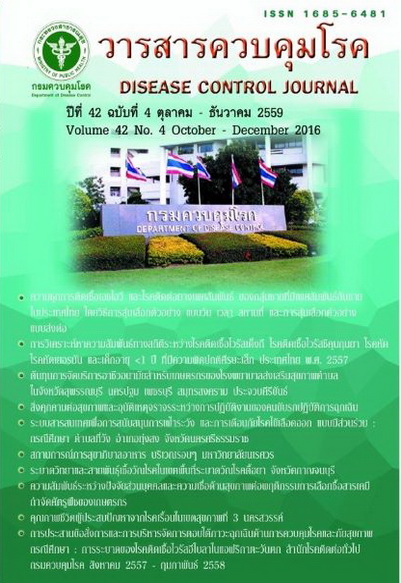A prevalence survey of HIV and sexually transmitted infection among men who have sex with men (MSM), Thailand: venue day time sampling (VDTS) and respondent driven sampling (RDS)
DOI:
https://doi.org/10.14456/dcj.2016.1Keywords:
MSM, HIV prevalence, VDTS, RDSAbstract
Bureau of Epidemiology established the Integrated Biological and Behavioral Surveillance (IBBS) in MSM because HIV prevalence was continually high in this population. VDTS was used as sampling technique at the first-time meanwhile method of RDS has been developed to work since 2014. The objectives of this study aim to determine the HIV/STI prevalence and compare both sampling methods that were perspective on surveillance system. The study design was serial cross-sectional survey, conducted RDS in 2 provinces (Ratchaburi, Chonburi) and VDTS in 3 provinces (Bangkok, Chaing-Mai, Phuket). 1,681 MSM were recruited, using palmtop assisted self-interview (PASI) which was instrument for self-complete questionnaires. The urine and oral fluid sample were collected for Neisseria gonorrhoeae (NG), Chlamydia trachomatis (CT) and HIV-antibody testing. The results of this study showed the mean of HIV prevalence was 9.7% (Max 19.8%, Min 1.9%). Ratchaburi Province was highest STI prevalence both CT and NG that showed 8.4% infected CT and 2.8% infected NG in 2014. VDTS and RDS showed a little different result cause of dissimilar analysis. Social network of contagion disease was showed by RDS while map of assemblage was showed by VDTS then using sampling technique depend on content of surveillance’s intension.
Downloads
References
2. Steuve A, O’Donnell LN, Duran R, Doval AS, Blome J. Time-space sampling in minority com¬munities: Results with young Latino men who have sex with men. Am J Public Health 2001;91:922-6.
3. สถาปนา เนาว์รัตน์, สามารถ ครุจิต, อัญชลี วรางค์รัตน์. เทคนิคการสุ่มตัวอย่างแบบวัน-เวลา-สถานที่ (venue-day-time sampling) ในการประเมินความชุกและพฤติกรรมเสี่ยงต่อการติดเชื้อเอชไอวีในกลุ่มผู้ชายที่มีเพศสัมพันธ์กับผู้ชายในประเทศไทย. รายงานเฝ้าระวังทางระบาดวิทยาประจำสัปดาห์ 2550;1:3-9.
4. Muhib FB, Lin LS, Steuve A, Miller RL, Ford WJ, Johnson WD, et al. A venue-based method for sampling hard-to-reach population. Public Health Reports 2001;116:216-22.
5. Mansergh G, Naorat S, Jommaroeng R, Jenkins AR, Jeeyapant S, Kanggarnrua K, et al. Adapta¬tion of venue-day-time sampling in Southeast Asia to access men who have sex with men for HIV assessment in Bangkok. Field Methods 2006;18:135-52.
6. ฟริส วัน กรีนสแวน, สมบัติ แทนประเสริฐสุข, ระพีพันธุ์ จอมมะเริง, แมนเสริฟ โกรดอน, สถาปนา เนาว์รัตน์, อัญชลี วรางรัตน์, และคณะ. ความชุกและปัจจัยเสี่ยงต่อการติดเชื้อเอชไอวีในกลุ่มชายรักชายในกรุงเทพมหานคร. วารสารควบคุมโรค 2547; 1:27-36.
7. Van Griensven F, Thanprasertsuk S, Jommaro¬eng R, Mansergh G, Naorat S, Jenkins RA, et al. Evidence of a previously undocumented epidemic of HIV infection among men who have sex with men in Bangkok, Thailand. AIDS 2005;19:521-6.
8. อัญชลี วรางค์รัตน์, ฟริส วัน กรีนสแวน, สถาปนา เนาว์รัตน์, วิภาส วิมลเศรษฐ, ธรีรัตน์ เชมนะสิริ, ฟิลิป มอค, และคณะ. ปัจจัยสู่ความสำเร็จในการประเมินความชุกและพฤติกรรมเสี่ยงในกลุ่มผู้ชายที่มีเพศสัมพันธ์กับผู้ชายในประเทศไทย พ.ศ. 2546- 2548. การประชุมวิชาการประชากรศาสตร์แห่งชาติ; วันที่ 23-24 พฤศจิกายน 2549; ห้องกษัตริย์ศึก 2 โรงแรมเดอะทวิน ทาวเวอร์, กรุงเทพมหานคร. กรุงเทพมหานคร: 2549.
9. Centers for Disease Control and Prevention. Prevalence of HIV infection among populations of men who have sex with men, Thailand, 2003 and 2005. Morb Mortal Wkly Rep 2006;31: 844-8.
10. ธนรักษ์ ผลิพัฒน์, กีรติกานต์ กลัดสวัสดิ์, ชมนาถ มโนไพบูลย์, ธรีรัตน์ เชมนะสิริ, ฟริทส วัน กรีนส แวน, วิภาส วิมลเศรษฐ, และคณะ. การป้องกันและแก้ไขปัญหาการติดเชื้อเอชไอวีในกลุ่มชายที่มีเพศสัมพันธ์กับชาย. พิมพ์ครั้งที่ 2. นนทบุรี: สำนักระบาดวิทยา กรมควบคุมโรค; 2551.
11. สุปิยา จันทรมณี. แนวทางการเฝ้าระวังการติดเชื้อเอชไอวี โรคติดต่อทางเพศสัมพันธ์ และพฤติกรรมที่สัมพันธ์กับการติดเชื้อเอชไอวีในกลุ่มชายที่มีเพศสัมพันธ์กับชายในพื้นที่ 5 จังหวัด ประเทศไทย พ.ศ. 2557. นนทบุรี: สำนักระบาดวิทยา กระทรวงสาธารณสุข; 2557.
12. สุปิยา จันทรมณี, นิรมล ปันสุวรรณ, อรพรรณ แสงวรรณลอย, ไพโรจน์ จันทรมณี. รายงานการเฝ้าระวังพฤติกรรมเสี่ยงและความชุกการติดเชื้อเอชไอวีในกลุ่มชายที่มีเพศสัมพันธ์กับชาย ปี พ.ศ. 2550-2553. นนทบุรี: สำนักระบาดวิทยา กระทรวงสาธารณสุข; 2555.
13. Qiaoqin Ma, Shidian Zeng, Shichang Xia, Xiaohong Pan, Dayong Wang, Haishen Zhu, et al. Risky sexual networks and concentrated HIV epidemics among men who have sex with men in Wenzhou, China: a respondent-driven sampling study. BMC Public Health [internet]. 2015 [cited 2016 Mar 5];14:1220. Available from: http://dx.doi.org/10.1186/s12889-015- 2591-7
14. Heather A Pines, Devid Goodman-Meza, Eileen V Pitpitan, Karla Torres, Shirley J Semple, Thomas L Patterson, et al. HIV testing among men who have sex with men in Tijuana, Mexico: a cross-sectional study. BMJ Open [internet]. 2016 [cited 2016 Mar 5];6:e010388. Available from:http://dx.doi.org/10.1136/bmjopen -2015-010388
15. Shilpa Hakre, Griselda B. Arteaga, Aurelio E. Nunez, Nelson Arambu, Bulbulgul Aumakhan, Michelle Liu, et al. Prevalence of HIV, Syphilis, and other sexually transmitted infections among MSM from three cities in Panama. Journal of Urban Health [internet]. 2014 [cited 2016 Mar 5];91:793-808. Available from: http:// dx.doi.org/10.1007/s11524-014-9897-0
16. Ju Nyeong Park, Erin Papworth, Serge Clotair Billong, Jean Bosco Elat, Sethson Kassegne, shley Grosso, et al. Correlates of prior HIV testing among men who have sex with men in Cameroon: a cross-sectional analysis. BMC Public Health [internet]. 2014 [cited 2016 Mar 5];14:1220. Available from: http//www.bio medcentral.com/1471-2458/14/1220
17. Andrea L Wirtz, Vincent Jumbe, Gift Trapence, Dunker Kamba, Eric Umar, Sosthenes Ketende, et al. HIV among men who have sex with men in Malawi: elucidating HIV prevalence and correlates of infection to inform HIV prevention. J Int AIDS Soc [Internet]. 2013 [cited 2016 Mar 5];16:18742. Available from: http://dx.doi. org/10.7448/IAS.16.4.18742
18. World Health Organization. Consolidated guidelines on HIV prevention, diagnosis, treatment and care for key populations. Geneva: World Health Organization; 2014.
19. Arlene C Chua, Mark IC Chen, Philippe Cavailler, Lili Jiang, Mohammed Ridzwan Abdullah, Oon Tek Ng, et al. Challenges of respondent driven sampling to assess sexual behaviour and estimate the prevalence of human immunodeficiency virus (HIV) and Syphilis in men who have sex with men. Ann Acad Med Singapore [internet]. 2013 [cited 2016 Mar 5];42:350-3. Available from: http://www. annals.edu.sg/pdf/42VolNo7Jul2013/V42N7 p350.pdf
20. Hong-Ha M. Truong, Michael Grasso, Yea- Hung Chen, Timothy A. Kellogg, Tyler Robert¬son, Alberto Curotto, et al. Balancing theory and practice in respondent-driven sampling: A case study of innovations developed to overcome recruitment challenges. PLoS ONE [internet]. 2013 [cited 2016 Mar 5];8:e70344. Available from: http://dx.doi.org/10.1371/journal.pone. 0070344
Downloads
Published
How to Cite
Issue
Section
License
Articles published in the Disease Control Journal are considered as academic work, research or analysis of the personal opinion of the authors, not the opinion of the Thailand Department of Disease Control or editorial team. The authors must be responsible for their articles.






